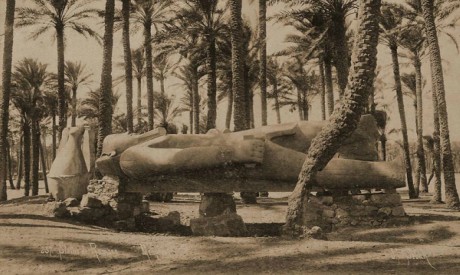http://english.ahram.org.eg/NewsContent/9/40/288334/Heritage/Ancient-Egypt/New-move-for-Ramses-.aspx
New move for Ramses
The colossal statue of the Pharaoh Ramses II that once stood in Cairo's Ramses Square will move to the Grand Egyptian Museum later this month

The relocation of the colossal statue of the ancient Egyptian Pharaoh Ramses II from Ramses Square in downtown Cairo to the Grand Egyptian Museum (GEM) overlooking the Giza Plateau received worldwide media coverage in 2006.
The red granite statue is to move again at the end of this month, when it starts its last journey to the permanent display area on the Grand Staircase at the entrance to the GEM. The move will be carried out by the Arab Contractors Company that was responsible for the previous move in 2006.
According to Tarek Tawfik, supervisor-general of the GEM, over the past three weeks the statue has been intensively studied to assess its condition before transportation. Safeguarding procedures have been put in place, and the foam rubber covering the statue has been replaced with stronger material and weak points consolidated.
The road on which the statue will be transported has been paved with special material to bear the weight of the 13m colossus.
"The statue is to be transported in its cage, but it has also been hung on a steel bridge like a pendulum to allow it to move freely during the 400m journey," Tawfik told Al-Ahram Weekly.
He said the Arab Contractors would use the same iron cage and vehicle used in the statue's 2006 transportation. This was specially created to support the weight of the 83-ton colossus. A trial to check the weight of the statue on the vehicle and the road has been implemented. The whole procedure has cost the GEM an amount of LE14 million while in 2006 it cost only LE6 million.
"After making its last journey, the statue of Ramses II will be the first major artefact to enter the permanent collection area of the GEM, the biggest museum in the world," Tawfik asserted.
This is also the fourth time this statue has been moved. The first was 3,000 years ago, shortly after it was carved in an Aswan quarry, when it was ferried down the Nile to Mit Rahina 30km from the Giza Plateau and installed at the Great Temple of Ptah.
In 1882, the statue was discovered broken into six pieces. Attempts to restore and re-erect it in situ failed, and it remained as it was found until former president Gamal Abdel-Nasser decided to erect the statue in front of Cairo's main railway station as a symbol of the country's authentic roots.
In February 1954, minister of governmental affairs Abdel-Latif Al-Boghdadi undertook to move the statue to Bab Al-Hadid (now Ramses Square) in Cairo, where the sculpture of "Egypt's Renaissance" by artist Mahmoud Mokhtar then stood.
The statue was transported to Bab Al-Hadid Square on a tank by the military engineering department to celebrate the second anniversary of the 1952 Revolution and Mokhtar's masterpiece was re-erected in front of Cairo University.
The statue was restored and reassembled in the square, now renamed Ramses Square, by the insertion of iron bars inside the body. A fountain was built in front of it, and it soon became one of Cairo's most famous landmarks, providing a backdrop for several famous film scenes and songs.
However, in subsequent years the square was redeveloped and the statue was largely hidden under a maze of cement structures and flyovers. Former culture minister Farouk Hosni then suggested removing the statue from its location in Ramses Square to protect it from pollution. Several possible new locations were suggested.
It was thought the statue might be returned to its original home at Mit Rahina, but the small local bridge could not have supported the weight of the statue. It was then suggested that it be placed in Giza's Rimaya Square, or at the entrance to the Cairo Opera House, but it was feared that in time these sites would also be affected by traffic fumes and congestion.
In 2002, the GEM was chosen as the permanent home of this magnificent colossus, and the statue made its third journey in 2006 from Ramses Square to the GEM grounds. Its fourth journey, when it will be installed in a place of honour inside the GEM, will take place at the end of this month.
*This story was first published in Al-Ahram Weekly newspaper
-- Sent from my Linux system.
No comments:
Post a Comment